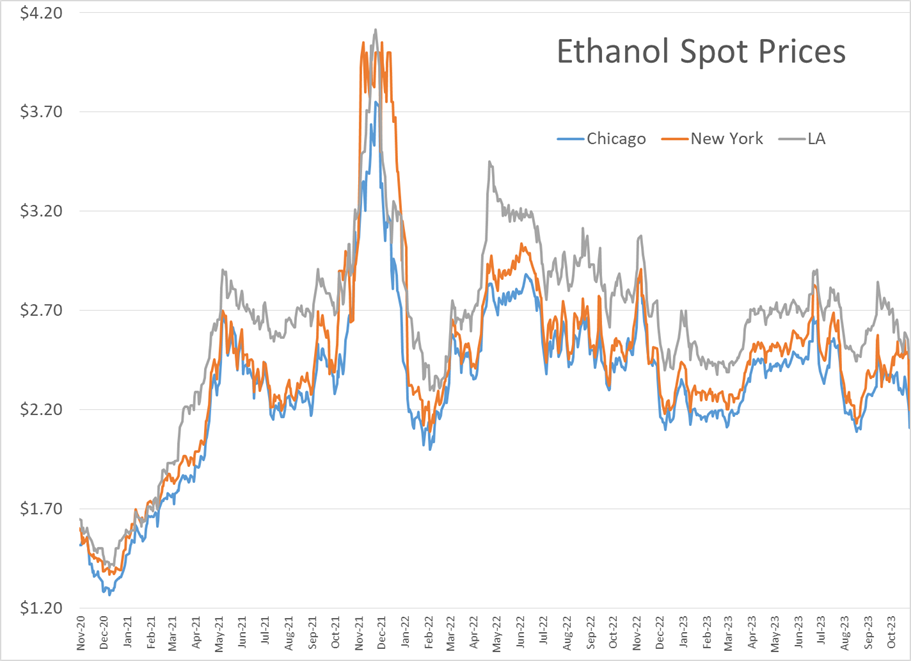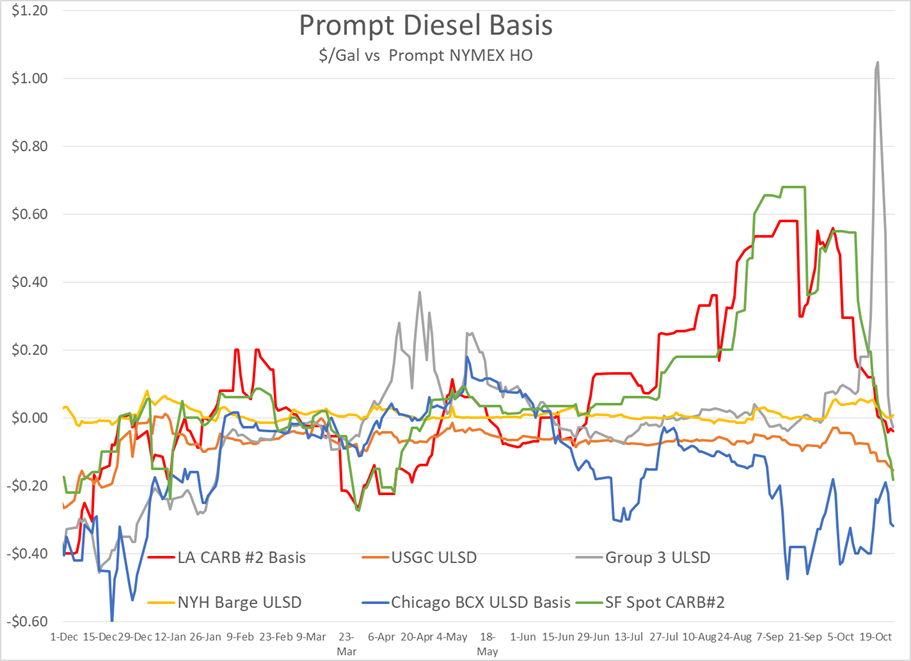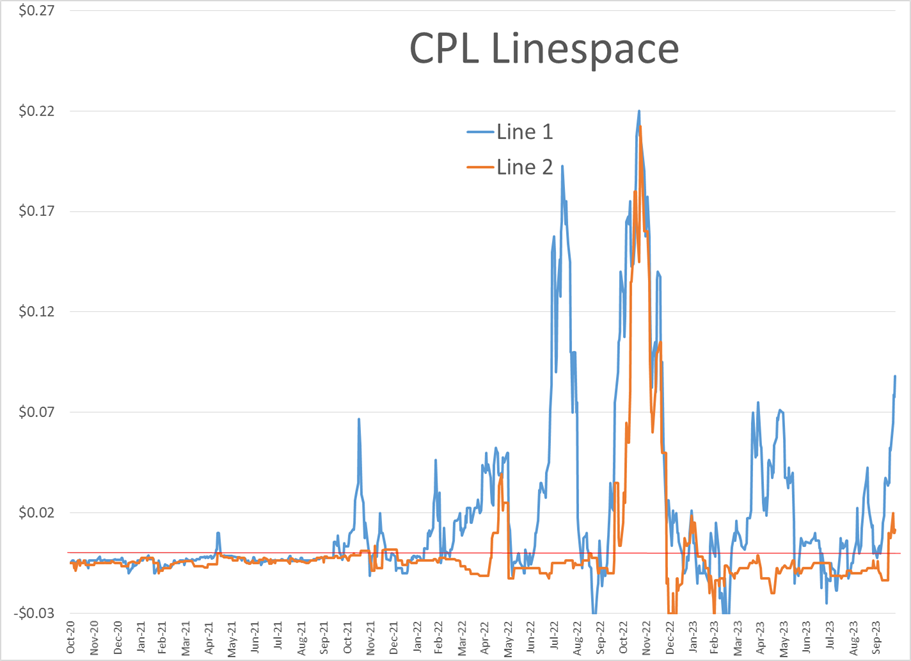Diesel Bulls: A Major Cold Front is About To Sweep Across The Country, Which Will Certainly Stir Up Some Heating Demand

Energy futures were jumping again overnight after US fighter jets hit Iranian-tied military targets in Syria, and the deal to lift sanctions in Venezuela already looks like it might be falling apart.
While the bulls have the early momentum, this latest in a series of rallies tied to fears of supply disruptions seems to be lacking the enthusiasm of earlier versions, and we’ll need to see another 8-10 cents of gains from refined products to break the downward trend on the weekly charts.
What a difference a week makes: If you needed ULSD in the Group 3 market last Friday, you needed to pay $1.05-$1.15/gallon premium over the November Futures contract to hit an offer. Today, those same barrels are being offered for a $.01 discount. While much less dramatic, we have seen steady selling in most other regional basis markets as well as physical traders are having to offer lower differentials to overcome the backwardation in futures. One hope for the diesel bulls: A major cold front is about to sweep across the country with 30-40 degree temperature drops forecast, which will certainly stir up some heating demand.
We continue so see stronger values for space on Colonial pipeline as Gulf Coast refiners seem to be having a hard time moving their excess supply. Both Line 1 and 2 values reached their highest levels of the year this week, as lower basis values for both gasoline and diesel along the Gulf Coast opens up the arbitrage window to ship barrels to New York. It’s not uncommon to see stronger line space values throughout the winter months as the weak demand season puts downward pressure on Gulf Coast values. This year the added element of major turnarounds at 2 East Coast refineries is likely contributing to the early strength as well.
Ethanol prices were already coming under pressure this week following weakness in the corn market, and that selling accelerated after the DOE’s weekly report showed a jump in ethanol inventory and production. Values are once again hovering near 2-year lows as we head into what are traditionally the weaker months for demand which could put more downside pressure on alcohol prices.
Q3 earnings releases have been a mixed bag so far, with a general theme of healthy profits that are a far cry from last year’s record setting figures.
Valero beat estimates as its refineries ran at 95% of capacity for the quarter and were able to capitalize on downtime at other facilities. The company’s renewable diesel operations saw nearly a 25% increase in volume from year ago levels, but profits were nearly cut in half as the drop in RIN and LCFS credits took a bite out of earnings. On the flip side, their ethanol earnings surged to nearly $200 million in the quarter from break even a year ago.
P66 also had a strong showing with $1.7 of the total $2.1 billion in earnings from the quarter coming from its refining operations, although those results were below many wall street estimates.
Exxon noted $2.4 billion in refining-related earnings for the quarter, up substantially from Q2 as its new Beaumont units helped the company hit record throughput rates along with strengthening crack spreads. An interesting bullet point in the Exxon earnings release was a negative mark-to-market impact on its trading operations, which will raise questions as the company’s relatively new strategy to leverage its trading expertise appears to be disappointing so far.
Click here to download a PDF of today's TACenergy Market Talk.
News & Views
View All
The Recovery Rally In Energy Markets Continues For A 3rd Day
The recovery rally in energy markets continues for a 3rd day with refined product futures both up more than a dime off of the multi-month lows we saw Wednesday morning. The DJIA broke 40,000 for the first time ever Thursday, and while it pulled back yesterday, US equity futures are suggesting the market will open north of that mark this morning, adding to the sends of optimism in the market.
Despite the bounce in the back half of the week, the weekly charts for both RBOB and ULSD are still painting a bearish outlook with a lower high and lower low set this week unless the early rally this morning can pick up steam in the afternoon. It does seem like the cycle of liquidation from hedge funds has ended however, so it would appear to be less likely that we’ll see another test of technical support near term after this bounce.
Ukraine hit another Russian refinery with a drone strike overnight, sparking a fire at Rosneft’s 240mb/day Tuapse facility on the black sea. That plant was one of the first to be struck by Ukrainian drones back in January and had just completed repairs from that strike in April. The attack was just one part of the largest drone attack to date on Russian energy infrastructure overnight, with more than 100 drones targeting power plants, fuel terminals and two different ports on the Black Sea. I guess that means Ukraine continues to politely ignore the White House request to stop blowing up energy infrastructure in Russia.
Elsewhere in the world where lots of things are being blown up: Several reports of a drone attack in Israel’s largest refining complex (just under 200kbd) made the rounds Thursday, although it remains unclear how much of that is propaganda by the attackers and if any impact was made on production.
The LA market had 2 different refinery upsets Thursday. Marathon reported an upset at the Carson section of its Los Angeles refinery in the morning (the Carson facility was combined with the Wilmington refinery in 2019 and now reports as a single unit to the state, but separately to the AQMD) and Chevron noted a “planned” flaring event Thursday afternoon. Diesel basis values in the region jumped 6 cents during the day. Chicago diesel basis also staged a recovery rally after differentials dropped past a 30 cent discount to futures earlier in the week, pushing wholesale values briefly below $2.10/gallon.
So far there haven’t been any reports of refinery disruptions from the severe weather than swept across the Houston area Thursday. Valero did report a weather-related upset at its Mckee refinery in the TX panhandle, although it appears they avoided having to take any units offline due to that event.
The Panama Canal Authority announced it was increasing its daily ship transit level to 31 from 24 as water levels in the region have recovered following more than a year of restrictions. That’s still lower than the 39 ships/day rate at the peak in 2021, but far better than the low of 18 ships per day that choked transit last year.
Click here to download a PDF of today's TACenergy Market Talk.

Energy Prices Found A Temporary Floor After Hitting New Multi-Month Lows Wednesday
Energy prices found a temporary floor after hitting new multi-month lows Wednesday morning as a rally to record highs in US equity markets and a modestly bullish DOE report both seemed to encourage buyers to step back into the ring.
RBOB and ULSD futures both bounced more than 6 cents off of their morning lows, following a CPI report that eased inflation fears and boosted hopes for the stock market’s obsession of the FED cutting interest rates. Even though the correlation between energy prices and equities and currencies has been weak lately, the spillover effect on the bidding was clear from the timing of the moves Wednesday.
The DOE’s weekly report seemed to add to the optimism seen in equity markets as healthy increases in the government’s demand estimates kept product inventories from building despite increased refinery runs.
PADD 3 diesel stocks dropped after large increases in each of the past 3 weeks pushed inventories from the low end of their seasonal range to average levels. PADD 2 inventories remain well above average which helps explain the slump in mid-continent basis values over the past week. Diesel demand showed a nice recovery on the week and would actually be above the 5 year average if the 5% or so of US consumption that’s transitioned to RD was included in these figures.
Gasoline inventories are following typical seasonal patterns except on the West Coast where a surge in imports helped inventories recover for a 3rd straight week following April’s big basis rally.
Refiners for the most part are also following the seasonal script, ramping up output as we approach the peak driving demand season which unofficially kicks off in 10 days. PADD 2 refiners didn’t seem to be learning any lessons from last year’s basis collapse and rapidly increased run rates last week, which is another contributor to the weakness in midwestern cash markets. One difference this year for PADD 2 refiners is the new Transmountain pipeline system has eroded some of their buying advantage for Canadian crude grades, although those spreads so far haven’t shrunk as much as some had feared.
Meanwhile, wildfires are threatening Canada’s largest oil sands hub Ft. McMurray Alberta, and more than 6,000 people have been forced to evacuate the area. So far no production disruptions have been reported, but you may recall that fires in this region shut in more than 1 million barrels/day of production in 2016, which helped oil prices recover from their slump below $30/barrel.
California’s Air Resources Board announced it was indefinitely delaying its latest California Carbon Allowance (CCA) auction – in the middle of the auction - due to technical difficulties, with no word yet from the agency when bidders’ security payments will be returned, which is pretty much a nice microcosm for the entire Cap & Trade program those credits enable.




